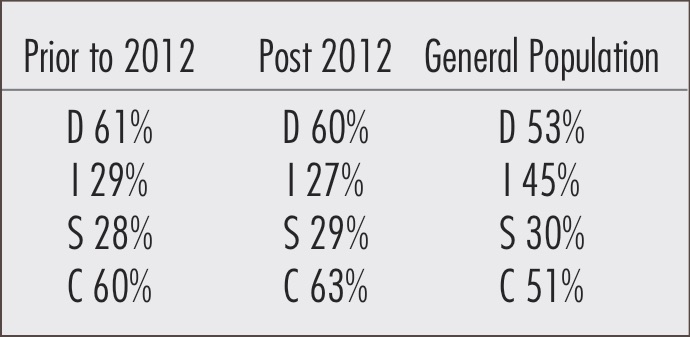We read so much these days about the importance of corporate culture. This is a standard subject in my many recent interviews with “Top Contractors to Work For.” We know that working in an elementary school is different from working on a job site, but what does the data say? And what are the implications of that data for you? Is construction different?
For the sake of simplicity, I define culture as “an integrated pattern of human knowledge, belief, and behavior.” Narrowing our focus for this conversation, we will consider behavior. Although it is dynamic, it is also observable, and elements can be measured. A simple tool for measuring behavioral preferences is the DISC model. Based on the work of psychologist William Marston in the 1920s, it is a popular, straightforward, standardized, and relatively easy way to assess behavioral styles and preferences.
Defining DISC
The DISC classifies people’s behavior into four types (Dominance, Influence, Steadiness, and Conscientiousness) by looking at their preferences on two scales: Task versus People, and Fast-paced versus Moderate-paced. This tool is used in many leadership-development programs and is a wonderful entry-level assessment that many construction pros are familiar with.
Since 2003, FireStarter administered DISC assessments to nearly 10,000 construction professionals. All trades, all areas of the country, and all levels of the organization are in the sample. I chose to divide my sample in half, and this got me to 2012. Running the analysis, I had my suspicions that there would be a difference pre- and post-2012. See for yourself:

Before you comment that this is more than 100%, I am looking at people who score with any of these dimensions as high. So, a person could be High D and High I, for example. I wasn’t looking for the highest score; I was looking for evidence and preference of a behavior.
The consistency between the two samples was a surprise. It certainly felt like the industry was seeing less of the D behavior, but maybe that was just the clients I was working for. There was some truth to that influencing my perception, as a closer review showed two newer clients are heavily S and C with nowhere near as much D as in the general industry. So, yes, the industry does have a D and C (Dominance and Conscientiousness) culture. With this confirmation, let’s discuss implications for you.
What the findings mean
First, play the odds. The odds are very high that the person sitting across from you has either Dominance or Conscientiousness as their dominant profile. They may even have both. This means that starting the conversation with relationship-building and unsolicited small talk will annoy them. They may be quite blunt, but it isn’t personal!
The D/Dominance Culture – Hallmarks of the D culture are quick decisions, direct answers, and a competitive atmosphere. Results matter, and trust is given to those who are direct and straight-forward. People who thrive in this culture are hard-driving individuals who relish challenges and the thrill of victory. Reading is a contact sport for them! Interpersonal communication will suffer in this culture, and those who are less assertive may feel overwhelmed and under-appreciated. The closer we get to the field, the more D we see.
The C/Conscientiousness Culture – The C culture is known for quality, order, and accuracy. High standards, diligent analysis, and diplomacy come first; all else is secondary. Perfect results are the expectation. Cynical to new ideas, you earn trust with this group by doing the job right, in their eyes. If one decimal point is good, then three must be better! This group can miss opportunities as they get mired in detail, and growth may suffer for fear of lowered execution during the growth phase. Many engineers are high in the C dimension.
The I/Influence Culture – Although we don’t see as many I’s in construction, let’s consider what this culture would look like. Creativity, enthusiasm and optimism are key attributes of this group. They never met a person they didn’t like, nor an idea they didn’t embrace. Life is an opportunity to express and High I’s will do that in a big way. These folks are extroverts and can be quite annoying to the High C and High D note above! They also can be wonderful leaders as they engage with people all the time. Sometimes light on details, like the High D, these people are positive and inspiring.
The S/Steadiness Culture – Perhaps one of the most misunderstood, the S’s get a bad rap. They are methodical and caring. They dot their i’s and cross their t’s but also deeply care about the team. Loyal, great listeners, they are the glue that holds a team together. However, because they are methodical, the High D and High I can push them to go faster and this will cause them to withdraw.
Another consideration is diversity of thought and behavior. Too many contractor organizations are peopled by clones who think the same way. The nature of the work does reward the D and C behaviors, but leaders have an opportunity here. This task-focused group-think leads to less-than-optimal decisions and outcomes. It may also create culture where people are not the most important asset.
Conflict is more likely with the D and C approach as the relationship is secondary. Understanding, listening, and collaboration are important for successful team development and project execution. But we all see unnecessary conflict on jobs all the time. Much of this is simply a default reaction based on personality rather than a thoughtful response based on self-awareness.
Knowing the industry culture, you are now able to calibrate your expectations as you deal with people. But shaping your team and company culture is where you gain competitive advantage. There is no one best style. All can lead, all can learn, all can make money. The key is to bring people together, in whatever proportion you are faced with, and set goals and expectations that all commit to.









